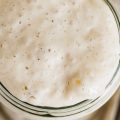I’m gonna tell you a secret – I love me some salty sourdough. While most bakers obsess over the perfect tangy flavor, I am partial to sodium-rich loaves sometimes. I just have days when I’m like: ‘What if we cranked up the salt dial to eleven?’ Let me share what I do and win you over to my side. Your bread basket will never be the same again.

Table of Contents
- First: Salt’s Role in Sourdough
- Adjusting Salt in Your Recipe
- Types of Salt to Use
- How to Enhance Saltiness
- Adding Salty Ingredients
- Timing and Fermentation
- Balancing Flavors
- Experimenting with Dough Hydration
- Extra Tips!
- Salty Sourdough Goodness!
- FAQs
First: Salt’s Role in Sourdough
Salt is not just about adding flavor; it actually aids in fermentation and texture development of your loaf.
Salt acts as a fermentation regulator. It helps to control the activity of the wild yeast and bacteria in your starter, preventing them from going into overdrive and producing overly sour or funky flavors. By adding the right amount of salt, you can strike a delicate balance between the tangy notes of fermentation and the overall flavor profile of your bread.
Have you ever wondered why your sourdough sometimes lacks that perfect chewy texture? Salt could be the missing piece of the puzzle. When salt is added to the dough, it strengthens the gluten network, resulting in a more elastic and structured crumb. This means your loaf will have a better oven spring, a more open crumb, and a satisfyingly chewy texture that’s the hallmark of great sourdough.
Now, here’s a pro tip: the timing of when you add salt to your dough matters. Many bakers prefer to add salt after the autolyse stage (when the flour and water are mixed and allowed to rest). This allows the gluten to develop without the interference of salt, resulting in a smoother and more extensible dough. Once the autolyse is complete, the salt is incorporated, and the dough is ready for the bulk fermentation stage.
So, how much salt should you use in your sourdough? A general rule of thumb is to use 2% salt by weight of the total flour. This means for every 1000 grams of flour, you’d add 20 grams of salt.
However, feel free to adjust this based on your taste preferences.
Adjusting Salt in Your Recipe
If you’re craving a saltier sourdough loaf, the solution is simple: adjust the salt quantity in your recipe. By increasing the amount of salt, you can enhance the flavor profile of your bread and achieve that satisfyingly savory taste you’re after.
How do you do it?
Start by incrementally increasing the salt in your recipe. If your current recipe calls for 2% salt by weight of the total flour, try bumping it up to 2.5% or even 3%. This slight adjustment can make a noticeable difference in the overall flavor of your bread without overwhelming the other nuances.
Not all salts are created equal. Experimenting with different types of salt can add an extra layer of flavor to your sourdough. Try using sea salt, kosher salt, or even flavored salts like garlic or rosemary salt. Each variety will contribute its unique characteristics to your loaf, allowing you to customize the taste to your liking.
Keep in mind that increasing the salt in your recipe may affect the behavior of your dough. Salt can slow down fermentation, so you might need to adjust your proofing times or even the amount of starter you use. Be prepared to make slight tweaks to your process as you find the perfect salt balance for your sourdough.

Types of Salt to Use
The type of salt you choose can make a significant difference in the flavor profile of your bread.
- Sea salt is a fantastic choice for sourdough baking. Its coarser texture and slightly briny taste can add a delightful depth of flavor to your loaf. The larger crystals of sea salt also provide a satisfying crunch when sprinkled on top of your bread before baking. Just remember to adjust the amount of salt in your recipe if you’re using sea salt, as its larger granules can pack more of a salty punch than table salt.
- Kosher salt is a favorite among many bakers, and for good reason. Its flaky texture and clean taste make it an ideal choice for sourdough bread. Kosher salt dissolves easily into the dough, ensuring even distribution of saltiness throughout your loaf. Plus, its coarser grind compared to table salt allows for better control over the amount of salt you’re adding to your recipe.
- While table salt may not have the same gourmet appeal as sea salt or kosher salt, it’s still a perfectly acceptable choice for sourdough baking. Its fine granules dissolve quickly into the dough, making it easy to achieve a consistent level of saltiness. Just keep in mind that table salt is often more densely packed than other varieties, so you may need to use a bit less to achieve the same level of flavor.
Prices pulled from the Amazon Product Advertising API on:
Product prices and availability are accurate as of the date/time indicated and are subject to change. Any price and availability information displayed on [relevant Amazon Site(s), as applicable] at the time of purchase will apply to the purchase of this product.
How to Enhance Saltiness
One effective technique to ensure even salt distribution throughout your sourdough is to dissolve the salt in water before adding it to the dough. This simple step helps the salt penetrate the dough more uniformly, leading to a consistent level of saltiness in every bite.
To do this, simply measure out the required amount of salt and dissolve it in a portion of the water you’ll be using for your dough. Once the salt has fully dissolved, add this saltwater to your flour mixture and proceed with your recipe as usual. This pre-dissolving method is particularly useful when using coarser salts like sea salt or kosher salt, which may not distribute as evenly as finer table salt.
Another technique is to sprinkle salt directly onto the dough surface before shaping or folding. This method creates pockets of concentrated saltiness that can add bursts of flavor to your finished loaf.
After your dough has completed its bulk fermentation, gently turn it out onto a lightly floured surface. Sprinkle a small amount of salt evenly over the surface of the dough. As you shape your loaf or perform your final folds, the salt will be incorporated into the dough, creating flavorful layers throughout.
Keep in mind that this technique can lead to uneven salt distribution if not done carefully, so use a light hand and make sure to fold or shape your dough thoroughly to ensure the salt is well-integrated. This method works best as a complement to, rather than a replacement for, the salt already incorporated into your dough during mixing.
Adding Salty Ingredients
So many ingredients not only go with salty sourdough, but enhance the salty flavor as well!
- Olives are a fantastic way to add a salty kick to your sourdough. Roughly chop your olives and fold them into the dough during the final shaping stage. As the bread bakes, the olives will release their salty juices, infusing your loaf with a delightful tanginess that complements the sourdough’s natural flavor.
- Cheese lovers, rejoice! Try adding grated Parmesan, crumbled feta, or diced aged cheddar to your dough. As the cheese melts and browns in the oven, it will create pockets of salty goodness throughout your loaf. Just be sure to use a firm, dry cheese that won’t make your dough too wet.
- For a subtle salty crunch, consider adding seeds to your sourdough. Salted sunflower seeds, pumpkin seeds, or even everything bagel seasoning can add a delightful texture and flavor to your bread. Simply sprinkle the seeds over your shaped loaf before baking, or fold them into the dough during the final shaping stage. The seeds will toast up beautifully in the oven, adding a nutty, salty note to every bite.
Timing and Fermentation
Extending the fermentation time can make your sourdough more salty. Allowing your dough to ferment for longer periods gives microorganisms more time to create a deeper, more complex flavor profile and break down gluten for a more tender and digestible loaf.
Find the sweet spot (or salty spot??) in fermentation timing to enhance the saltiness of your sourdough. Aim for a bulk fermentation of 4-6 hours at room temperature, followed by an overnight retardation in the refrigerator. This two-step process allows the dough to develop a complex flavor while preventing over-proofing.
Experiment with different fermentation techniques, such as longer, slower fermentation at a lower temperature or incorporating stretch and folds during bulk fermentation to distribute salt evenly.
Balancing Flavors
While salt plays a crucial role in enhancing the overall taste of your bread, it’s important to consider how it interacts with the other flavors at play.
Sourdough is known for its tangy, acidic notes, which come from the lactic acid produced during the fermentation process. The key is to find a harmony between this natural sourness and the saltiness you desire. Too much salt can overpower the delicate tang, while too little may leave your bread tasting flat.
One way to achieve this balance is by adjusting the ratio of starter to flour in your recipe. A higher proportion of starter will yield a more acidic loaf, which can stand up to a bit more salt without being overwhelmed. On the other hand, if you prefer a milder sourdough, you may want to use less starter and a touch less salt to maintain that subtle flavor equilibrium.
Another factor to consider is the potential sweetness in your sourdough. While not as prominent as the tanginess, some sourdough recipes incorporate a small amount of honey, sugar, or even dried fruit to add a hint of sweetness. In these cases, you may need to slightly increase the salt to counterbalance the added sweetness and prevent your bread from tasting cloying.

Experimenting with Dough Hydration
Did you know that the amount of water in your sourdough dough can actually impact how salty it tastes? It’s true! Playing around with your dough’s hydration levels can be a simple yet effective way to enhance the perceived saltiness of your bread without actually adding more salt.
Here’s the science behind it: salt dissolves in water, so the more water your dough contains, the more diluted the salt becomes. Conversely, a drier dough with less water will have a higher concentration of salt, making it taste saltier.
So, if you’re looking to amp up the salty factor in your sourdough, try reducing the hydration of your dough. Start by decreasing the water content by 5-10% and see how it affects the flavor. Keep in mind that lower hydration doughs can be a bit more challenging to work with, as they tend to be firmer and less extensible.
On the other hand, if you find your sourdough is tasting a bit too salty for your liking, increasing the hydration can help balance things out. A wetter dough will dilute the salt, resulting in a milder flavor. Just be careful not to go overboard, as overly high hydration can lead to a slack, difficult-to-handle dough.
As you experiment with different hydration levels, pay attention to how the dough feels and behaves. Adjust your kneading and shaping techniques accordingly to ensure you still end up with a well-structured loaf. And of course, take notes on how the changes in water content affect the flavor of your finished bread.
Extra Tips!
- Experiment with the amount of salt in your sourdough recipe. While a standard 2% salt by flour weight is a great starting point, don’t be afraid to bump it up to 2.5% or even 3% to achieve a more pronounced salty flavor. Keep in mind that even small increments can make a noticeable difference, so adjust gradually until you find your perfect balance.
- Invest in high-quality, flavorful salts for your sourdough baking. While table salt gets the job done, switching to artisanal salts like fleur de sel, Maldon sea salt, or Himalayan pink salt can elevate the flavor profile of your bread. These salts often have a more complex taste and a pleasant texture that can enhance the overall eating experience.
- Get creative with salty mix-ins to boost the savory factor in your sourdough. Try folding in ingredients like chopped olives, capers, or even crispy bacon bits during the final shaping stage. These salty additions not only bump up the overall saltiness but also introduce new flavors and textures to your loaf.
- For an extra hit of salty goodness, try brushing your sourdough with salted butter as soon as it comes out of the oven. As the hot bread absorbs the butter, it will also take on some of that delicious saltiness. This technique works particularly well with crusty loaves like boules or bâtards, creating a mouthwatering contrast between the crisp, salty exterior and the tender, tangy crumb.
- Finally, don’t underestimate the impact of fermentation on the perceived saltiness of your sourdough. Longer, slower fermentation can help develop more complex flavors, including a more pronounced saltiness. If you find your loaves are lacking in salt flavor, try extending your bulk fermentation or proofing times to allow the dough more time to develop. Just be sure to keep an eye on your dough to prevent over-proofing.
Salty Sourdough Goodness!
Even with more salt in your sourdough flavor, you’ll still be able to create a mouthwatering loaf. Bite into your final creation, feeling the satisfying crunch of salt crystals and savoring the intense flavor burst.
Remember, crafting the perfect salty sourdough isn’t just about dumping in more salt.
Embrace the power of salt in your sourdough baking and savor the delicious results!
FAQs
How to add salt to sourdough?
Add salt to your sourdough during the initial mixing stage, along with the flour and water. The typical amount is 1.8-2% of the flour’s weight. Dissolve the salt in a small portion of the water used in the recipe to ensure even distribution. Incorporate this saltwater mixture into the dough while combining all ingredients.
What if I forgot the salt in my sourdough?
If you forgot to add salt to your sourdough, you can still incorporate it during the first fold or stretch and fold process. Sprinkle the salt evenly over the dough’s surface, then proceed with the folding. This method ensures the salt is well-distributed throughout the dough. Keep in mind that the dough may be slightly sticky initially but will absorb the salt during subsequent folds.
How to get more sourdough flavor?
To enhance the sourdough flavor, try the following techniques:
– Use a mature, active starter with a lower hydration level (stiffer consistency).
– Extend the fermentation time by proofing the dough in the refrigerator for 12-48 hours.
– Incorporate whole grain flours, which provide more complex flavors.
– Experiment with different flour combinations and ratios to find your preferred taste profile.
Is sourdough supposed to be salty?
Sourdough bread should have a noticeable but balanced salt flavor. The saltiness helps to enhance the overall taste profile and complements the tang from the sourdough starter. However, the bread should not be overly salty. A typical sourdough recipe uses 1.8-2% salt relative to the flour’s weight, which provides the right balance of flavor without being overwhelming.
















